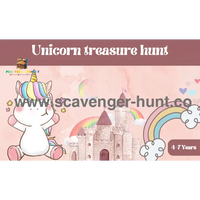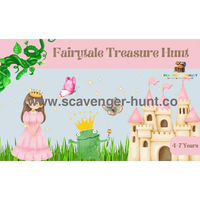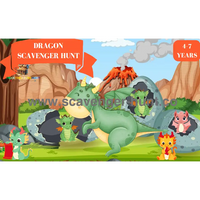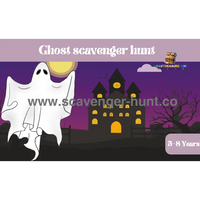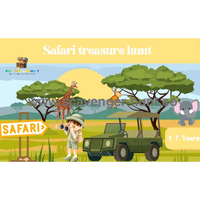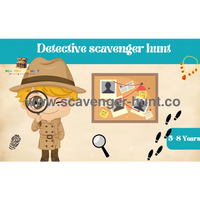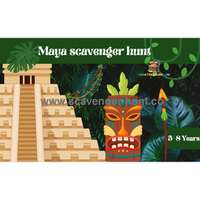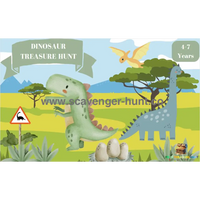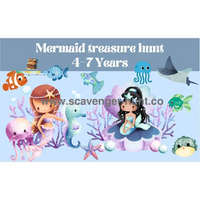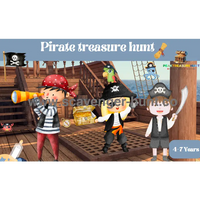🧭Your Ultimate Guide To Treasure Hunts: 14 Common Questions Answered
Treasure hunts have been a beloved activity for generations, combining elements of adventure, problem-solving, and excitement. Whether you're planning to organize one or join in the fun, you may have some questions about how treasure hunts work. In this comprehensive guide, we'll address the 14 most common questions about treasure hunts.
1. What is a treasure hunt?
A treasure hunt is a captivating and engaging recreational activity that has been enjoyed by people of all ages for generations. At its core, a treasure hunt is a thrilling adventure where participants embark on a journey filled with mystery, excitement, and discovery. The primary objective of a treasure hunt is for participants to follow a series of clues or riddles carefully crafted by the organizers to ultimately locate a hidden "treasure."
Now, let's delve deeper into what makes a treasure hunt such a cherished and versatile pastime:
The Quest for Hidden Riches: While the term "treasure" often conjures images of chests filled with gold and jewels, it's important to note that treasure hunts can take on various forms. The treasure can be a physical prize, such as a gift or a valuable item, but it can also be intangible, like the sheer thrill of solving intricate puzzles and overcoming challenges. This diversity in the nature of the treasure adds an element of surprise and keeps participants eagerly anticipating the final revelation.
A Journey of Exploration: Treasure hunts are not merely about finding the end goal; they are about the journey itself. Participants are immersed in a world of curiosity and intrigue, where each clue uncovered and each riddle solved brings them closer to their destination. It's a process that encourages critical thinking, teamwork, and problem-solving skills, making it an ideal activity for both leisure and educational purposes.
Creativity Knows No Bounds: One of the most fascinating aspects of treasure hunts is the boundless realm of creativity they encompass. Organizers have the freedom to craft clues and riddles that align with a chosen theme, whether it's a pirate adventure, a historical quest, or a detective mystery. This thematic approach not only adds excitement but also sets the stage for immersive storytelling and role-playing.
Adaptable to All Ages: Treasure hunts are incredibly versatile and can be tailored to suit participants of all ages. Simple hunts with straightforward clues are perfect for younger children, providing them with a sense of achievement and wonder. On the other hand, more complex and challenging hunts are designed to captivate the minds of teenagers and adults, ensuring that the experience remains engaging and rewarding for all.
In essence, a treasure hunt is much more than a mere recreational activity; it's a journey into the realms of imagination, adventure, and camaraderie. It's an opportunity to unlock the mysteries hidden within clues and to revel in the satisfaction of unraveling the unknown. So, whether you're organizing a treasure hunt for a special occasion or participating in one for the thrill of the chase, remember that the true treasure lies in the unforgettable memories and the joy of exploration.

2. How do I organize a treasure hunt?
Organizing a treasure hunt involves several steps:
- Define the theme and purpose.
- Create clues and riddles.
- Select a location.
- Set up the treasure.
- Gather participants.
- Provide rules and instructions.
- Oversee the hunt and award prizes.
Organizing a treasure hunt is an exhilarating venture that allows you to craft an exciting and memorable experience for participants. To ensure a successful treasure hunt, it's essential to follow a structured approach and pay attention to key details. Here's a comprehensive guide on how to organize a treasure hunt that will captivate and delight participants:
Step 1: Define the Theme and Purpose
The first and foremost step in organizing a treasure hunt is to define the theme and purpose of the adventure. The theme sets the tone for the entire hunt and adds an element of immersion and excitement. Whether it's a pirate-themed quest, a detective mystery, a historical exploration, or a unique concept of your own, the theme should align with the interests and preferences of the participants.
The purpose of the treasure hunt can vary. It could be a fun activity for a birthday party, a team-building exercise for a corporate event, or an educational adventure for students. Understanding the purpose helps in tailoring the hunt to achieve specific goals.
Step 2: Create Clues and Riddles
One of the most crucial aspects of a treasure hunt is crafting engaging clues and riddles. These are the heart of the adventure, guiding participants from one location or challenge to the next. Clues should be cleverly designed to be challenging yet solvable, encouraging critical thinking and teamwork.
Consider incorporating the theme into your clues and riddles to enhance the overall experience. Wordplay, puzzles, and riddles that match the theme add depth to the adventure.
Step 3: Select a Location
Choosing the right location is pivotal in creating a captivating treasure hunt. The location should align with the theme and purpose of the hunt. It can be hosted in various settings, such as parks, beaches, gardens, or even indoors in your home.
Ensure that the location is safe for participants and has the necessary permissions if it's a public space. Familiarize yourself with the layout and potential hiding spots to strategically place clues and the final treasure.
Step 4: Set up the Treasure
The treasure is the ultimate goal of the hunt, and its setup should be consistent with the theme. Depending on the theme and purpose, the treasure can range from physical prizes, like gifts or valuable items, to symbolic treasures, such as a certificate of accomplishment or the satisfaction of completing the hunt.
Ensure that the treasure is well-hidden but not inaccessible, as the joy of discovery is a significant part of the adventure.
Step 5: Gather Participants
Inviting participants is the next step. Determine the number of participants based on the location's capacity and the nature of the hunt. Send out invitations with all the necessary details, including the date, time, meeting point, and any special instructions related to the theme.
Encourage participants to come prepared, dressed according to the theme if applicable, and ready for an adventure.
Step 6: Provide Rules and Instructions
Before the treasure hunt begins, gather all participants and provide them with clear rules and instructions. Explain the objective of the hunt, the role of clues, and any safety guidelines. Emphasize the importance of teamwork, collaboration, and sportsmanship.
Step 7: Oversee the Hunt and Award Prizes
As the treasure hunt unfolds, assume the role of the organizer or host. Be prepared to provide assistance if needed and ensure that the hunt progresses smoothly. Keep track of the participants' progress and, most importantly, be ready to award prizes to the victorious team or individual.
Remember that the treasure hunt is not just about finding the treasure; it's about the journey and the shared experience. Encourage participants to enjoy every moment of the adventure, from deciphering clues to solving riddles, and celebrate their accomplishments.
By following these organized steps, you can orchestrate a treasure hunt that will be cherished and remembered as an exciting and rewarding adventure for all participants. So, let the hunt begin, and may the thrill of discovery lead to unforgettable moments!

3. What materials do I need for a treasure hunt?
Materials for a treasure hunt include:
- Clues and riddles.
- A treasure or prize.
- Writing materials.
- Maps or diagrams.
- Props or decorations (optional).
- A timer (for competitive hunts).
- A list of participants.
Organizing a successful treasure hunt requires careful preparation and gathering the necessary materials to ensure a seamless and enjoyable experience for participants. Here's a detailed description of the materials you'll need for a treasure hunt:
1. Clues and Riddles:
- Clues and riddles form the backbone of the treasure hunt. These are the puzzles and hints that guide participants from one location to the next in their quest to find the treasure.
- Create a series of well-thought-out clues and riddles that are aligned with the theme and level of complexity you desire for your treasure hunt. Consider incorporating wordplay, puzzles, and thematic elements to enhance the challenge.
2. A Treasure or Prize:
- The treasure is the ultimate goal of the treasure hunt, and it serves as the reward for participants' efforts.
- Depending on the nature and purpose of the hunt, the treasure can be a physical item, such as a gift, a collection of items, or even a symbolic treasure like a certificate of achievement.
- Ensure that the treasure is appropriately hidden and matches the theme of the hunt.
3. Writing Materials:
- You'll need writing materials, such as pens, markers, and paper, to create and record clues, riddles, and any additional instructions.
- Having extra writing materials on hand is advisable, especially if participants need to write down their answers or notes during the hunt.
4. Maps or Diagrams:
- Depending on the complexity of your treasure hunt, you may require maps or diagrams of the hunt location.
- Maps can be helpful in guiding participants through larger areas or locations with intricate layouts.
5. Props or Decorations (Optional):
- Props and decorations can add an immersive and thematic element to your treasure hunt.
- Consider using props that align with the theme, such as pirate hats for a pirate-themed hunt or detective props for a mystery-themed hunt. Decorations like banners or themed signage can also enhance the experience.
6. A Timer (for Competitive Hunts):
- If your treasure hunt is competitive and involves teams or individuals racing against each other, a timer is essential.
- Set specific time limits for each part of the hunt to create a sense of urgency and excitement.
7. A List of Participants:
- Keep a comprehensive list of all participants, including their names and any relevant contact information.
- This list will help you keep track of who is participating, ensure everyone's safety, and distribute any necessary materials or instructions.
When gathering these materials, it's crucial to consider the age and preferences of the participants, as well as the overall theme and purpose of the treasure hunt. Tailoring the materials to the specific needs of your treasure hunt will contribute to a memorable and enjoyable adventure for all involved.
Remember that a well-organized treasure hunt can spark creativity, teamwork, and a sense of accomplishment among participants, making it a fantastic activity for various occasions and age groups.

4. Where can I host a treasure hunt?
Treasure hunts can be hosted in various locations, such as parks, beaches, gardens, or even indoors in your home. The choice depends on the theme and the age group of participants.
When it comes to hosting a treasure hunt, the options for locations are diverse, allowing you to tailor the experience to your specific theme and the age group of participants. The choice of location plays a significant role in shaping the adventure and adding depth to the treasure hunt. Here's a comprehensive description of potential venues for hosting a treasure hunt:
1. Parks:
- Parks are popular and versatile locations for treasure hunts. They offer open spaces, natural elements, and often have designated trails or paths that can be used for the hunt.
- Park settings are ideal for treasure hunts with nature-themed or outdoor adventure themes. Participants can explore wooded areas, follow trails, and engage with the environment.
2. Beaches:
- Beaches provide a unique and picturesque backdrop for treasure hunts. The combination of sand, water, and coastal landscapes adds an element of excitement to the adventure.
- Beach treasure hunts are well-suited for themes related to pirates, buried treasures, or coastal mysteries. Participants can search along the shoreline and dunes for clues and hidden treasures.
3. Gardens:
- Botanical gardens or well-maintained public gardens offer a tranquil and scenic setting for treasure hunts.
- These locations are perfect for treasure hunts with themes centered around nature, floral elements, or even enchanted gardens. Participants can explore pathways, discover hidden corners, and solve clues amidst the beauty of the gardens.
4. Indoor Settings (Home or Venue):
-
Hosting a treasure hunt indoors is a versatile option, especially if you have limited outdoor space or are concerned about weather conditions.
-
Indoor treasure hunts can be customized to suit various themes, such as mystery, detective, or even historical adventures. Participants can explore different rooms, solve puzzles, and uncover secrets within a controlled environment.
5. Historical Sites:
- Historical sites, such as old buildings, castles, or heritage properties, offer a rich and immersive backdrop for treasure hunts.
- These locations are perfect for historical or time-travel-themed treasure hunts. Participants can delve into the past, decipher clues related to the site's history, and uncover hidden artifacts.
6. Urban Settings:
- Urban areas, such as city streets or neighborhoods, can be transformed into treasure hunt landscapes.
-
Urban treasure hunts are ideal for modern or city-themed adventures. Participants can navigate streets, visit landmarks, and solve urban mysteries while enjoying the urban ambiance.
7. Specific Venues:
- Depending on the theme and purpose of the treasure hunt, you can choose specific venues that align with the storyline. For example, a museum, zoo, or library could serve as a unique setting for a themed treasure hunt.
When selecting a location for your treasure hunt, consider the age group and physical capabilities of the participants. Ensure that the chosen venue is safe and accessible for all involved. Additionally, make any necessary arrangements, such as permissions for public spaces or reservations for private venues.
Ultimately, the location sets the stage for the treasure hunt's excitement and adventure. By carefully selecting a venue that complements your theme and caters to the participants' interests, you can create a memorable and enjoyable treasure hunt experience.

5. How can I create clues and riddles for a treasure hunt?
Creating clues and riddles is a creative process. You can base them on the theme of the hunt, use wordplay, or incorporate puzzles. The key is to make them challenging but solvable, leading participants to the next location.
Crafting engaging and intriguing clues and riddles is a crucial aspect of designing a successful treasure hunt. These elements serve as the driving force behind the adventure, guiding participants from one location to the next while adding an element of challenge and excitement. Here's a comprehensive description of how to create clues and riddles for your treasure hunt:
1. Define the Theme and Purpose:
- Begin by establishing the theme and purpose of your treasure hunt. The clues and riddles should align with the overarching narrative or storyline. Consider whether you want the hunt to be educational, adventurous, or purely for entertainment.
2. Use Wordplay:
- Wordplay is a valuable tool for crafting clues and riddles. Utilize puns, homophones, anagrams, and cryptic language to add depth to your puzzles.
- For example, if your treasure hunt theme is pirate-related, you might create a clue like, "X marks the spot where the treasure's kept, beneath the palm tree where pirates have stepped."
3. Incorporate Puzzles:
- Puzzles can add an extra layer of complexity to your clues. Consider using logic puzzles, math problems, or visual puzzles that participants must solve to progress.
- An example of a puzzle clue might be, "To reach the next clue's location, you must find the sum of 5 + 12, then head to that numbered gate."
4. Make Them Solvable:
- While it's essential to make clues challenging, they should still be solvable with logical thinking. Avoid making them overly cryptic or frustratingly difficult.
- Ensure that participants have the necessary information or tools to decipher the clues. If you include a riddle about a landmark, make sure the landmark is visible or described clearly.
5. Create a Narrative Flow:
- Arrange the clues in a logical sequence that follows the narrative flow of your treasure hunt. Each clue should lead naturally to the next location, building anticipation and excitement.
- If your treasure hunt has a storyline, integrate elements of the story into the clues to immerse participants in the adventure.
6. Test the Clues:
- Before the treasure hunt begins, test the clues with a small group to ensure they are solvable and lead participants to the intended locations.
- Gather feedback from testers to make any necessary adjustments and refine the clues for a smoother experience.
7. Provide Visual Aids (Optional):
- Visual aids, such as maps, images, or diagrams, can complement textual clues. They can offer hints or confirm that participants are on the right track.
- Visual aids can be especially helpful for younger participants or hunts with complex locations.
8. Consider Age and Audience:
- Tailor the complexity of the clues to the age group and experience level of the participants. Clues for children should be age-appropriate and straightforward, while those for adults can be more intricate.
9. Keep Clues Safe and Weatherproof:
- If your treasure hunt is outdoors, protect clues from the elements by laminating them or placing them in sealed containers. Ensure that clues are securely hidden to prevent tampering.
10. Maintain a Sense of Fun:
- Above all, maintain a sense of fun and adventure throughout the treasure hunt. Clues and riddles should enhance the overall enjoyment of the experience.
Remember that the quality of your clues and riddles significantly impacts the participants' engagement and satisfaction. Well-crafted clues not only challenge participants but also immerse them in the storyline and make the treasure hunt a memorable and enjoyable activity.

6. What are some popular themes for treasure hunts?
Popular themes for treasure hunts include:
- Pirate adventures.
- Detective mysteries.
- Historical quests.
- Nature exploration.
- Scavenger hunts for specific items.
Themes add excitement and context to the hunt, making it more engaging.
When it comes to organizing a treasure hunt, selecting a theme can elevate the excitement and engagement of the participants. Themes provide context, narrative, and a sense of adventure to the treasure hunt experience. Here's a comprehensive description of some popular themes for treasure hunts that can make your event memorable:
1. Pirate Adventures:
-
Pirate-themed treasure hunts are timeless classics. Participants can become swashbuckling pirates in search of buried treasure. Maps, compasses, and nautical clues add authenticity to the theme.
2. Detective Mysteries:
-
Detective-themed treasure hunts turn participants into sleuths solving a mysterious case. Clues, suspects, and hidden evidence guide them through a thrilling investigative journey.
3. Historical Quests:
-
Historical treasure hunts transport participants to a specific time period or historical event. Clues and riddles are inspired by historical facts and figures, immersing players in the past.
4. Nature Exploration:
-
Nature-themed treasure hunts encourage participants to explore the great outdoors. Clues lead them to natural wonders, wildlife sightings, or scenic viewpoints, fostering a connection with the environment.
5. Scavenger Hunts for Specific Items:
- Instead of a traditional treasure, participants search for specific items or a list of objects. This theme can be adapted for various occasions, such as Easter egg hunts or themed scavenger hunts.
6. Fantasy Worlds:
-
Fantasy-themed treasure hunts take participants on a journey to magical realms, enchanted forests, or mythical lands. Clues and challenges are inspired by fantasy literature and folklore.
7. Adventure Quests:
-
Adventure-themed hunts mimic the thrill of explorers and adventurers. Participants embark on a quest to discover hidden artifacts, solve ancient puzzles, and overcome obstacles.
8. Movie or Book-Inspired Themes:
-
Treasure hunts inspired by popular movies, books, or TV shows can be a hit among fans. Themes like "Harry Potter," "Indiana Jones," or "The Hobbit" bring beloved stories to life.
9. Holiday and Seasonal Themes:
-
Treasure hunts can be adapted to fit various holidays and seasons. For example, Halloween-themed hunts may involve spooky clues, while a Christmas hunt could lead to hidden presents.
10. Science and Educational Themes:
- Educational treasure hunts incorporate learning elements. Participants can solve science-related puzzles, explore a museum, or decode historical facts.
11. Cultural Exploration:
- Cultural-themed hunts introduce participants to the traditions, landmarks, and heritage of a specific culture or country. Clues may involve language, art, or cuisine.
12. Space and Sci-Fi Themes:
- Space-themed treasure hunts take participants on an intergalactic adventure. Clues revolve around planets, aliens, and cosmic mysteries.
13. Superheroes and Villains:
- Participants can become superheroes or detectives on a mission to thwart a supervillain's plot. Clues lead to encounters with fictional characters and challenges.
14. Sports and Olympics:
- Sports-themed treasure hunts can include challenges related to various sports or Olympic events. Participants compete in athletic tasks to progress.
Selecting the right theme depends on the interests of the participants and the occasion of the treasure hunt. A well-chosen theme enhances the overall experience, immersing participants in a world of adventure and excitement. Whether it's uncovering pirate treasures, solving mysteries, or embarking on historical quests, the theme sets the stage for a memorable treasure hunt.

7. How do I set up the final treasure or prize?
The final treasure should be hidden in a way that's consistent with the theme. For example, if it's a pirate-themed hunt, you might use a chest. Ensure that the prize is worth the effort participants put into the hunt.
The climax of a treasure hunt lies in the discovery of the final treasure or prize. This moment should be thrilling and satisfying for participants, rewarding them for their effort and ingenuity. Here's a comprehensive description of how to set up the final treasure or prize for your treasure hunt:
1. Consistency with the Theme:
- The final treasure or prize should align seamlessly with the chosen theme of your treasure hunt. This consistency enhances the immersive experience for participants. For example:
-
Pirate-Themed Hunt: Use a wooden chest or a weathered box to resemble a pirate's treasure chest.
-
Detective Mystery: A sealed envelope or a mysterious briefcase can hold the final clue or reward.
-
Historical Quest: Consider an antique-looking artifact or a historically relevant item.
-
Nature Exploration: A hidden natural gem, like a polished stone or a unique leaf, can serve as the final treasure.
2. Hidden but Discoverable:
- Ensure that the final treasure is well-hidden, but not excessively so. Participants should have a fair chance of finding it by solving the preceding clues and riddles.
- Consider placing the treasure in a location that relates to the theme. For instance, bury it in the sand for a beach-themed hunt or hide it behind a bookshelf for a library-themed adventure.
3. Make it Worthwhile:
- The prize should be worth the effort and excitement that participants invest in the treasure hunt. It can be a tangible item, a collection of items, or even an experience, depending on your budget and preferences.
- For children's treasure hunts, small toys, candies, or themed trinkets are popular choices.
-
Adult treasure hunts may include gift cards, themed merchandise, or an exclusive experience.
4. Safety Considerations:
- If your treasure hunt involves children or takes place in a public area, consider safety concerns. Avoid hiding items in potentially hazardous locations or locations accessible only to adults.
5. Protective Packaging:
- Protect the final treasure or prize from the elements and handling by placing it in a sealed container. This prevents damage or deterioration, especially if the hunt takes place outdoors or in adverse weather conditions.
6. Treasure Presentation:
- When participants discover the final treasure, presentation matters. Unveil it with flair to enhance the sense of accomplishment and excitement.
- Use dramatic reveals like opening a chest, unwrapping a mysterious package, or lifting a concealed lid.
7. Clues or Messages:
- Consider including a congratulatory note or a final clue with the treasure. This note can acknowledge the participants' efforts and provide closure to the adventure.
8. Capture the Moment:
- As participants find the final treasure, capture their reactions with photos or videos. These memories can be cherished and shared with others.
9. Group or Individual Rewards:
- Decide whether the final treasure is intended for individual participants or for the entire group. Tailor the size and nature of the prize accordingly.
10. Surprise Element:
- To make the discovery even more exciting, introduce an element of surprise. It could be confetti, balloons, or a celebratory soundtrack playing when the treasure is found.
The final treasure or prize is the culmination of the treasure hunt adventure, and its setup should be carefully planned to create a memorable and rewarding experience. By following these guidelines and considering the theme, safety, and participants' preferences, you can ensure that the treasure's discovery is a highlight of your treasure hunt event.

8. What age groups are suitable for treasure hunts?
Treasure hunts can be tailored to suit various age groups. Simple hunts with easy clues are great for young children, while more complex challenges can be designed for teens and adults. It's all about adapting the hunt to the participants' abilities.
Treasure hunts are versatile and adaptable activities that can be enjoyed by a wide range of age groups. The key to a successful treasure hunt is tailoring it to the participants' abilities and interests. Here's a comprehensive description of the age groups that are suitable for treasure hunts and how to customize the experience for each group:
1. Young Children (Ages 3-6):
-
Treasure hunts for young children should be simple and straightforward. Use colorful visuals and easily recognizable objects as clues.
- Clues can involve basic shapes, colors, or simple riddles that match their cognitive development.
- Themes like animals, fairy tales, or superheroes often resonate with this age group.
2. Children (Ages 7-12):
- Children in this age group can handle slightly more complex challenges. Clues can involve wordplay, simple math, or basic puzzles.
- Themes can be diverse, including pirates, detective mysteries, or fantasy adventures.
- Ensure safety precautions and supervision if the hunt takes place in a public area.
3. Teenagers (Ages 13-18):
- Teens are capable of solving more intricate puzzles and riddles. Clues can be cryptic, requiring critical thinking.
- Themes can be tailored to their interests, such as mystery novels, pop culture, or historical events.
- Competitive elements, timed challenges, or team-based hunts can engage teenagers.
4. Adults (Ages 18+):
- Adults can enjoy treasure hunts with sophisticated clues, challenging riddles, and intricate narratives.
- Themes can range from historical mysteries to sophisticated heists or elaborate adventures.
- Consider incorporating physical challenges or activities for added excitement.
5. Mixed-Age Groups:
-
Treasure hunts can be designed to accommodate mixed-age groups by adjusting the complexity of clues. Provide options for both younger and older participants.
- Team-based hunts with intergenerational teams can foster cooperation and family bonding.
6. Corporate or Team-Building Events:
-
Treasure hunts can be adapted for corporate team-building events. Challenges can be tailored to align with specific organizational goals and themes.
- Focus on fostering collaboration, problem-solving, and communication among team members.
7. Special Occasions and Parties:
-
Treasure hunts can add excitement to various special occasions, including birthdays, anniversaries, or holidays.
- Customize the hunt to match the theme of the celebration and the age group of the guests.
8. Educational Settings:
-
Treasure hunts can be used as educational tools in schools, museums, or nature reserves. Clues can incorporate educational content relevant to the age group.
9. Seniors (Ages 60+):
-
Seniors can enjoy treasure hunts adapted to their physical abilities and cognitive levels.
- Consider gentle outdoor hunts in nature or themed hunts that tap into their life experiences.
The suitability of a treasure hunt for different age groups lies in the adaptability of the organizer. By tailoring the complexity of clues, themes, and challenges, treasure hunts can cater to participants of all ages. Whether it's a simple hunt for young children, a thrilling adventure for teens, or a sophisticated mystery for adults, treasure hunts offer endless possibilities for fun and engagement across generations.

9. Are there safety considerations for treasure hunts?
Safety is paramount. Ensure that the location is safe, and participants are aware of any hazards. Provide clear guidelines and supervision for younger participants. If the hunt takes place in public spaces, respect the environment and other people.
When organizing a treasure hunt, prioritizing safety is of utmost importance. Ensuring the well-being of all participants is essential for a successful and enjoyable experience. Here's a comprehensive description of safety considerations to keep in mind when planning a treasure hunt:
1. Choose a Safe Location:
- Select a location for the treasure hunt that is safe and suitable for the age group of the participants. Consider factors like terrain, accessibility, and potential hazards.
- Inspect the chosen location in advance to identify any potential risks, such as uneven ground, obstacles, or dangerous areas.
2. Hazard Identification:
- Conduct a thorough hazard assessment of the treasure hunt route and hide locations. Remove or mitigate any identified hazards to ensure participant safety.
- Be aware of natural elements like wildlife, insects, or weather conditions that could pose risks, especially in outdoor hunts.
3. Age-Appropriate Challenges:
- Tailor the challenges, clues, and activities to the age and physical capabilities of the participants. Avoid tasks that could be too strenuous or unsafe.
- Ensure that younger children are not exposed to age-inappropriate challenges.
4. Clear Guidelines and Instructions:
- Provide participants with clear and concise guidelines and safety instructions before the treasure hunt begins.
- Emphasize the importance of following rules, respecting boundaries, and reporting any concerns.
5. Supervision:
- Assign responsible adults or supervisors, especially when organizing treasure hunts for children. Their role is to oversee the event, ensure safety, and provide assistance if needed.
- Maintain open communication channels with supervisors throughout the hunt.
6. Emergency Contacts:
- Have a list of emergency contacts readily available in case of accidents or unforeseen incidents. Include local authorities, medical services, and contact information for participants' parents or guardians.
7. First Aid Kit:
- Carry a basic first aid kit with essential supplies, including bandages, antiseptic wipes, and any necessary medications.
- Designate someone who is trained in first aid to handle minor injuries.
8. Respect the Environment:
- If the treasure hunt takes place in public spaces or natural settings, promote environmental responsibility. Instruct participants to respect the environment by not littering and avoiding damage to flora and fauna.
9. Time Management:
- Ensure that the treasure hunt has a defined time frame. Avoid conducting hunts during extreme weather conditions, such as intense heat or storms.
- Plan the hunt to conclude before it gets dark to enhance safety.
10. Communication Devices:
- In case of larger or more complex treasure hunts, consider providing participants or supervisors with communication devices like cell phones or walkie-talkies for emergency contact.
11. Inclusivity and Accessibility:
- Make accommodations for participants with special needs or disabilities, ensuring that the treasure hunt is accessible to all.
12. Public Spaces and Permits:
- If the treasure hunt involves public spaces or private property, obtain any necessary permits or permissions to ensure legal compliance.
13. Debriefing:
- After the treasure hunt, conduct a debriefing session to gather feedback and address any safety concerns or incidents. Use this information to improve future hunts.
Prioritizing safety considerations in your treasure hunt planning ensures that all participants have a secure and enjoyable experience. By proactively addressing potential risks and maintaining clear communication, you can create a memorable adventure while safeguarding the well-being of everyone involved.

10. Can I do a treasure hunt indoors or outdoors?
Absolutely! Treasure hunts can be adapted for both indoor and outdoor settings. Indoor hunts can be great for rainy days or themed parties, while outdoor hunts offer more space and opportunities for adventure.
One of the wonderful aspects of organizing a treasure hunt is its versatility. Whether you prefer the cozy confines of indoor spaces or the wide-open expanses of the outdoors, treasure hunts can be adapted to suit both environments. Here's a comprehensive description of how you can successfully host treasure hunts indoors and outdoors:
Indoor Treasure Hunts:
1. Suitable for All Weather Conditions:
-
Indoor treasure hunts are an ideal choice when the weather is less than favorable. You won't have to worry about rain, snow, or extreme heat affecting the hunt.
2. Themed Adventures:
-
Indoor treasure hunts provide an opportunity to create themed adventures that match the surroundings. You can design hunts that take place in a specific room, a whole house, or even within a single large building.
3. Variety of Settings:
- Explore various indoor settings, including your home, a school, a community center, or a museum. Each location offers a unique backdrop for your treasure hunt.
4. Puzzle Challenges:
- Indoor hunts can incorporate puzzles, riddles, and clues hidden in furniture, books, or everyday objects. The familiarity of the indoor environment can add an extra layer of intrigue.
5. Controlled Environment:
- You have greater control over the environment indoors, allowing you to set up surprises, special effects, or themed decorations to enhance the treasure hunt experience.
Outdoor Treasure Hunts:
1. Expansive Adventures:
-
Outdoor treasure hunts provide ample space for expansive adventures. You can explore parks, gardens, forests, beaches, and urban areas to create diverse and exciting hunts.
2. Nature Exploration:
- Take advantage of outdoor settings to incorporate nature exploration into the treasure hunt. Participants can learn about local flora and fauna while solving clues.
3. Physical Challenges:
- Outdoor hunts can include physical challenges such as running, climbing, or navigating natural obstacles. They encourage participants to stay active and engage with the environment.
4. Scenic Beauty:
- Outdoor hunts often offer stunning natural scenery and picturesque landscapes that add to the overall experience. Participants can enjoy the beauty of their surroundings while hunting for clues.
5. Real-World Interaction:
-
Outdoor hunts may involve interactions with the public or strangers. Ensure participants are aware of etiquette and safety when engaging with others.
6. Seasonal Adaptability:
-
Outdoor treasure hunts can be adapted to different seasons, offering seasonal themes and challenges. For example, a winter hunt can involve tracking footprints in the snow.
7. Permits and Permissions:
- Keep in mind that certain outdoor locations may require permits or permissions for organized events. Check with local authorities and property owners when planning outdoor hunts.
In conclusion, the choice between indoor and outdoor treasure hunts depends on your preferences, the theme of the hunt, and the age group of the participants. Both settings offer unique advantages and opportunities for creativity. Whether you're seeking the coziness of an indoor themed adventure or the excitement of an outdoor exploration, treasure hunts can be tailored to create unforgettable experiences in either environment.

11. What are good clues for a treasure hunt?
Creating engaging and clever clues is a crucial part of planning a successful treasure hunt. Clues should be challenging enough to make the hunt exciting but solvable with some thought and creativity. Here are some types of clues and examples that you can use for your treasure hunt:
1. Rhyming Clues:
- Rhyming clues add a fun and poetic element to the hunt.
- Example: "To find your next clue, look where you snooze, it's where you lay your head and tie your shoes."
2. Picture Clues:
- Provide pictures or images that lead participants to the next location.
- Example: Show a picture of a tree to lead to a treehouse.
3. Anagram Clues:
- Rearrange the letters of a word to create a clue.
- Example: "LANTERN" becomes "ENTRANL," leading to the entrance hall.
4. Rebus Clues:
- Use pictures or symbols to represent words or parts of words.
- Example: Show a picture of an eye, a heart, and a book to lead to the library.
5. Clues within Clues:
- Each clue leads to the next clue, creating a series of steps.
- Example: Clue 1: "Where you sleep at night." Clue 2 (found under a bed): "Where you keep your clothes."
6. Number Clues:
- Incorporate numbers that correspond to a location or item.
- Example: "Look for the drawer with the number of letters in 'treasure.'"
7. Directional Clues:
- Provide directions to guide participants to the next location.
- Example: "Go north three paces, then east two paces to find your next clue."
8. Wordplay Clues:
- Use puns, homophones, or wordplay to create clues.
- Example: "You'll find the clue where things are heating up!" (near a stove or fireplace)
9. Historical or Educational Clues:
- Incorporate historical facts or educational information related to the location.
- Example: "Find the clue where you can learn about ancient civilizations."
10. Cipher Clues: - Encode the clue using a simple cipher, and provide a key for participants to decode it. - Example: "Rsvcmr hrmw xli jvsqwxli." (Shift each letter one position back in the alphabet to decode.)
11. Sound Clues: - Use sounds or musical notes to lead participants to the next location. - Example: Play a recording of a bell ringing, indicating the bell tower.
12. Object-Based Clues: - Provide a physical object that participants must interact with to reveal the next clue. - Example: A locked box with a key hidden nearby, leading to the next clue.
13. Environmental Clues: - Use elements in the environment as clues. - Example: "Follow the riverbank until you find the blue rock."
14. Storytelling Clues: - Create a narrative that unfolds as participants solve each clue. - Example: "You're on a journey. Your next destination is where the story began."
Remember to tailor your clues to the theme and age group of your treasure hunt. Additionally, consider the difficulty level and make adjustments if necessary to ensure that participants have a challenging but enjoyable experience.

12. What is the meaning of treasure hunting?
Treasure hunting refers to the activity of searching for valuable items, artifacts, or treasures that are hidden or buried, often with the aim of discovering historical, cultural, or monetary treasures. The meaning of treasure hunting can vary depending on the context:
-
Historical and Archaeological Treasure Hunting: In this context, treasure hunting involves searching for historical artifacts, relics, and items of cultural significance. Archaeologists and historians often engage in treasure hunting to uncover and preserve pieces of the past. This type of treasure hunting is typically conducted with careful documentation and adherence to legal and ethical guidelines.
-
Sunken Treasure Hunting: Sunken treasure hunting involves exploring underwater sites, such as shipwrecks, in search of valuable cargo, precious metals, or artifacts. It can be associated with maritime archaeology and the recovery of items lost at sea.
-
Modern-Day Treasure Hunting: In a recreational or hobbyist sense, treasure hunting refers to the search for items of value, often through the use of metal detectors or clues. This can include seeking buried caches of coins, jewelry, or other valuable items hidden by individuals or groups.
-
Geocaching: Geocaching is a contemporary form of treasure hunting where participants use GPS devices to hide and seek containers, called "geocaches," at specific locations marked by coordinates all over the world. It's a recreational and often community-driven activity.
-
Cultural and Mythical Treasure Hunting: Some treasure hunting pursuits are based on legends, myths, or folklore that suggest the existence of hidden treasures, such as lost cities or mythical hoards. These quests often combine historical research with adventurous exploration.
-
Legal and Ethical Considerations: Treasure hunting activities can raise legal and ethical questions, especially when they involve historical or archaeological sites. Many countries have laws and regulations governing the exploration and excavation of historical sites to protect cultural heritage.
Overall, treasure hunting encompasses a wide range of activities, from scientific archaeological investigations to recreational pursuits driven by the thrill of discovery. The meaning and purpose of treasure hunting can vary widely, but it often involves a quest for hidden or valuable items that hold historical, cultural, or personal significance.

13. Where can I hide clues for a treasure hunt?
When creating a treasure hunt or scavenger hunt with riddles, you can hide clues both indoors and outdoors to add variety and excitement to the game. Here are some hiding place ideas for riddles, categorized into indoor and outdoor locations:
Indoor Hiding Places:
-
Under a Couch Cushion: Place a clue under a cushion on a couch or sofa.
-
Inside a Kitchen Appliance: Hide a clue inside a microwave, refrigerator, or dishwasher.
-
In a Closet: Place a clue inside a closet among clothes or other items.
-
Inside a Bookshelf: Place a clue between books or inside a specific book.
-
Behind a Mirror: If you can safely remove a wall mirror, hide a clue behind it.
-
In a Drawer: Place a clue inside a drawer, such as a desk drawer or kitchen drawer.
-
Inside a Shoebox: Hide a clue inside a shoebox among pairs of shoes.
-
In a Laundry Basket: Place a clue inside a laundry basket filled with clothes.
-
Behind a Painting: Hide a clue behind a framed painting or artwork on the wall.
-
Inside a DVD Case: If you have a collection of DVDs, place a clue inside one of the cases.
Outdoor Hiding Places:
-
Under a Rock: Hide a clue under a large rock or stone in a garden or outdoor area.
-
Inside a Flower Pot: Place a clue inside a flower pot in a garden or on a patio.
-
Beneath a Doormat: Hide a clue under a doormat or welcome mat at the entrance.
-
Inside a Birdhouse: If there's a birdhouse nearby, place a clue inside it.
-
Under a Park Bench: Hide a clue beneath a park bench in a local park.
-
Inside a Tree Stump: Place a clue inside a hollowed-out tree stump.
-
Behind a Garden Gnome: If you have garden decorations, hide a clue behind one.
-
Inside a Mailbox: With permission, place a clue inside a mailbox in a residential area.
-
Under a Garden Statue: Hide a clue beneath a garden statue or ornament.
-
Inside a Playground Equipment: If the hunt is for children, place a clue inside a playground equipment feature, like a slide or swing.
Remember to consider the safety and accessibility of the hiding spots, especially when children or individuals with mobility challenges are participating. Also, ensure that the clues are protected from the elements if the outdoor treasure hunt takes place in inclement weather.

14. What is the difference between a treasure hunt and a scavenger hunt?
Treasure hunts and scavenger hunts are both fun, interactive games, but they have some key differences:
Treasure Hunt:
-
Objective: In a treasure hunt, the primary objective is to find a hidden "treasure" or prize. Participants follow a series of clues or riddles that lead them to the ultimate treasure.
-
Clues: Treasure hunts typically involve a series of clues that participants must solve to progress from one location to the next. These clues often require solving puzzles or riddles.
-
End Goal: The end goal of a treasure hunt is to reach the final location where the treasure is hidden. This could be a physical object, a collection of items, or simply the satisfaction of solving the hunt.
-
Theme: Treasure hunts can have various themes, such as pirate adventures, historical quests, or mystery-solving, which add an element of storytelling and excitement to the game.
-
Competition: Treasure hunts can be competitive or non-competitive, depending on the organizer's preferences. Some treasure hunts are timed, and participants compete to be the first to find the treasure.
Scavenger Hunt:
-
Objective: In a scavenger hunt, the objective is to find a specific list of items or complete tasks. Participants are given a list of items to locate, and they must collect or identify as many items as possible within a set time frame.
-
List of Items: Scavenger hunts involve a predefined list of items or tasks that participants need to find or complete. The emphasis is on finding and collecting rather than solving clues.
-
End Goal: The end goal of a scavenger hunt is to locate all or as many items as possible from the provided list. There is usually no "treasure" in the traditional sense.
-
Theme: Scavenger hunts can also have themes, but the focus is on finding specific items related to the theme. For example, a nature-themed scavenger hunt might involve finding specific types of leaves, rocks, or wildlife.
-
Competition: Scavenger hunts can be competitive, with participants racing to find items, or non-competitive, where the goal is simply to complete the list at a leisurely pace.
In summary, the main difference between a treasure hunt and a scavenger hunt lies in the objective. Treasure hunts focus on solving clues to find a hidden treasure, while scavenger hunts involve finding specific items or completing tasks from a predetermined list. Both types of hunts can be tailored to various themes and age groups, making them versatile and enjoyable activities for different occasions.

Discover our Complete Scavenger Hunts Collection.
With these answers to your most pressing questions about treasure hunts, you're ready to embark on your own exciting quest or organize a memorable treasure hunt for others. Happy hunting!


















